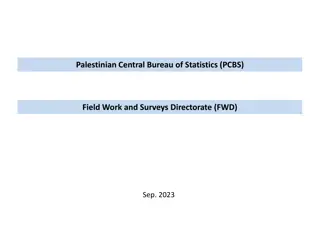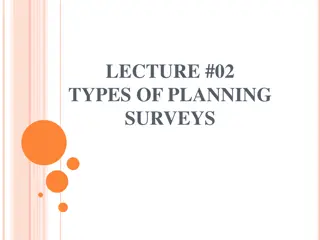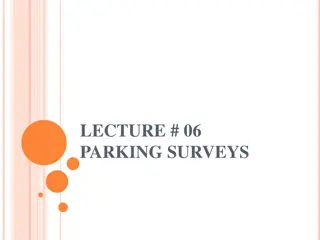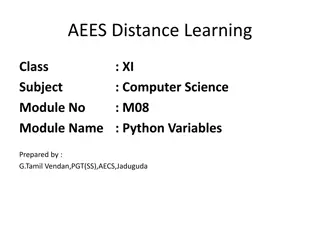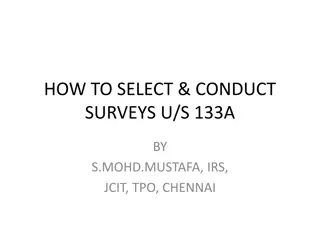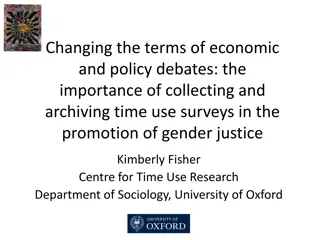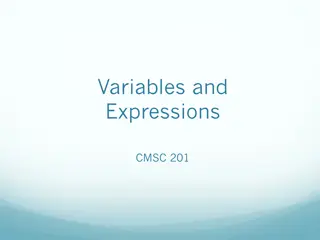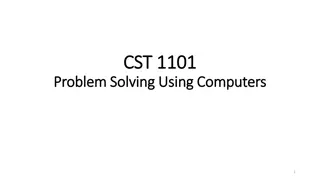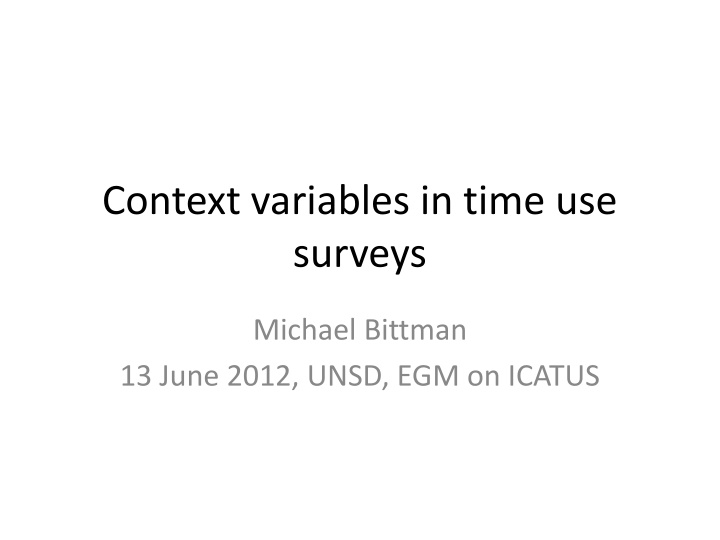
Time Use Surveys: Key Elements and Trends Revealed
Explore the significance of time use surveys, including background questionnaires, household dynamics, and crucial variables. Delve into trends like walking behaviors in the USA from 1965 to 2003, shedding light on physical activity patterns over the years.
Download Presentation

Please find below an Image/Link to download the presentation.
The content on the website is provided AS IS for your information and personal use only. It may not be sold, licensed, or shared on other websites without obtaining consent from the author. If you encounter any issues during the download, it is possible that the publisher has removed the file from their server.
You are allowed to download the files provided on this website for personal or commercial use, subject to the condition that they are used lawfully. All files are the property of their respective owners.
The content on the website is provided AS IS for your information and personal use only. It may not be sold, licensed, or shared on other websites without obtaining consent from the author.
E N D
Presentation Transcript
Context variables in time use surveys Michael Bittman 13 June 2012, UNSD, EGM on ICATUS
Elements of time use survey 1. Background questionnaire (including household form) Provides key information on ohousehold (composition etc.), orespondents (demographics, labour force status) and osome other crucial variables(health conditions, care-givers flag, non-parental childcare, outsourced household services)
Hours per week housework Husband s share of couples income
Elements of time use survey 1. Background questionnaire (including household form) Provides key information on ohousehold (composition etc.), orespondents (demographics, labour force status) and osome other crucial variables(health conditions, care-givers flag, non-parental childcare, outsourced household services)
Elements of time use survey2 2. Time diary or best substitute o Ideally start, finish times of primary and secondary activities o Some question about the kind of day the diary day was o Often some global questions about time pressure or the reverse o and some information about context of activities , typically * where activity took place * If in motion, mode of transport * company present when activity took place (includes alone ) * For whom activity was undertaken * Whether paid or not * Whether ICT device used during this activity
Trends in walking USA 1965-2003 Table 2 Prevalence*of walking behaviours, sports and exercise, and total physical activity Proportion of doers 1965 1975 1985 1992 1994 2003 (N = 1651) (N = 1555) (N = 2923) (N = 7527) (N = 19714) Physical activity variable n n n n n % % % % % (95% CI) (95% CI) (95% CI) (95% CI) (95% CI) Any walking 39 57 443 1577 3720 2.4 3.7 15.2 21.0 18.9 (1.6; 3.1) (2.7; 4.6) (13.9; 16.5) (20.0; 21.9) (18.3; 19.4) Walking for exercise 39 57 85 NA 1073 2.4 3.7 2.9 5.4 (1.6; 3.1) (2.7; 4.6) (2.3; 3.5) (5.1; 5.8) Walking for transport NA NA 105 1244 2845 3.6 16.5 14.4 (2.9; 4.3) (15.7; 17.4) (13.9; 14.9) Walking the dog NA NA 275 408 506 9.4 5.4 2.6 (8.3; 10.5) (4.9; 5.9) (2.3; 2.8) Sports/exercise** 97 188 501 1438 2427 5.9 12.1 17.1 19.1 12.3 (4.7; 7.0) (10.5; 13.7) (15.8; 18.5) (18.2; 20.0) (11.9; 12.8) Total physical activity*** 134 237 850 2602 5540 8.1 15.2 29.1 34.6 28.1 (6.8; 9.4) (13.5; 17.0) (27.4; 30.7) (33.5; 35.6) (27.5; 28.7) NA = data not available; *Prevalence estimates age-standardized to the 2000 US. census population using age groups 18 24 years, 25 34 years, 35 44 years, 45 64 years, and 65 years or older; **walking for exercise not included, with the exception of 1992 1994 which might have contained walking for exercise; ***all walking and sports/exercise considered, no double-counting
Mobile phone use from context variable in 2007 Time Diary
Some difficulties measuring elder care ABS data had care-giver flag, with tough eligibility criteria Yet mean time spent in caring for adults very low, much lower that expected from other sources Problem of non-self-identifying care-givers However, care-giver had a distinctively high domestic labour times i.e. long in cooking, laundry and cleaning than comparable non- care-givers Issues with joint production? A care-givers time signature , can be used to revise estimate and reach hidden carers



